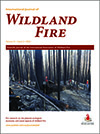International Journal of Wildland Fire
Volume 31
Number 2 2022
On the Dampier Peninsula, north-west Australia, Indigenous rangers, pastoralists and other stakeholders have collaborated to manage fire since 2016. The project has successfully changed fire regimes in ways that support biodiversity, cultural and economic values, showing the benefits of cross-tenure approaches to landscape-scale problems.
We measured post-fire field plots across the north-western USA to identify relationships between Composite Burn Index (CBI) and eight field measures and assessed how these relationships varied with forest structure. Most field measures corresponded well to CBI, but CBI underpredicts some independent burn severity measures in stands with large trees and does not fully capture levels of extreme burn severity.
Statistical modelling was used to relate Airborne Laser Scanning (ALS) data to field-measured canopy fuel metrics important to wildfire behaviour in black spruce stands. Resulting models can be used to map canopy fuel attributes at multiple scales in Alberta, Canada.
Machine learning models were developed to relate weather data to chamise fuel moisture content in California. Forced with gridded numerical weather forecasts, these models provide gridded real-time live fuel moisture forecasts at high spatial and temporal resolution which can be used to identify regions with elevated wildfire potential.
Climate change increases the risk of dangerous forest fires. The Institute of Meteorology and Water Management implemented the Fire Weather Index (FWI) forecasting system based on the Canadian system. The system’s aim is to determine the risk of a fire and improve the work of fire services. This paper presents the results of the system validation.
Models of initial growth for fires in eucalypt forest litter were developed from observations in a combustion wind tunnel. Time to reach steady-state spread rate depended on wind speed and fuel moisture content. Results align with theoretical fire growth models but highlight the need to extend the results to field observation.
This work deals with the extension of the Balbi model to the field scale. The proposed model is physics oriented, fully predictive, faster than real time and tested against 148 shrubland fires picked up in the literature. A comparison with results provided by other models is also made.
For prescribed grassland burns, plume rise estimates were improved with a more realistic burn window (~3 h compared with 12-h standard). For most burns examined in this study, the Briggs method performed as well or better than the alternative approaches. Observations indicated that plumes often penetrated above the boundary layer.





